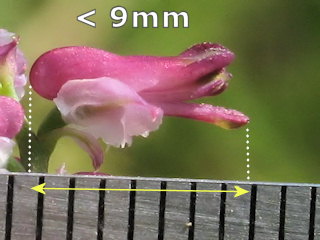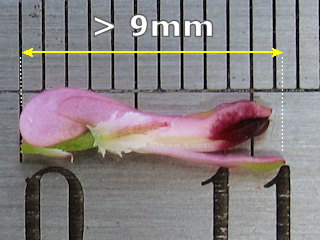Fumaria
L.
|
 Fummitory Fummitory
 Dahnet l-art Dahnet l-art
     |
| Taxa left beyond this couplet: 15 F. agrariaF. barnolaeF. bastardiiF. bastardii
(cleistogamic form)F. bicolorF. capreolataF. densifloraF. flabellataF. gaillardotiiF. muralisF. officinalis subsp. officinalisF. officinalis subsp. wirtgeniiF. parvifloraF. schleicheriF. vaillantii Description of Fumaria Annuals with erect, diffuse or climbing stems. Leaves cauline, 2- to 4-pinnatisect. Inflorescence racemose, bracteate, with short pedicels. Sepals 2, lateral. Corolla zygomorphic, consisting of a spurred upper petal, 2 inner petals, and a lower one. Fruit 1-seeded, indehiscent, showing 2 apical pits in the mesocarp when dry. In W. Europe mostly weeds of arable land, but in S. & E. Europe found also in rocky, sandy and grassy places. Measurments are meant for typical specimens growing in their natural habitat. Fumaria can form reduced, undeveloped or dwarfed structures in impoverished habitats.
Description by P. D. Sell extracted from Flora Europaea Vol 1-5
(Tutin et al., 1964-1993) |
| Fumaria key steps >> 1
| + + |
Widest parts of most leaf segments not more than 1.5mm |
ref |
OR
|
[A] Illustration of Lead 1.A + |
[B] Illustration of Lead 1.B - |
Identification Tips |

|

|
The corolla (=flower) is measured from end to end including the flaps at the mouth. For precission choose few mature flowers from different racemes / specimens and take an average. |
| Image of Fumaria densiflora by Stephen Mifsud | Image of Fumaria bastardii by Stephen Mifsud | - |
| |

